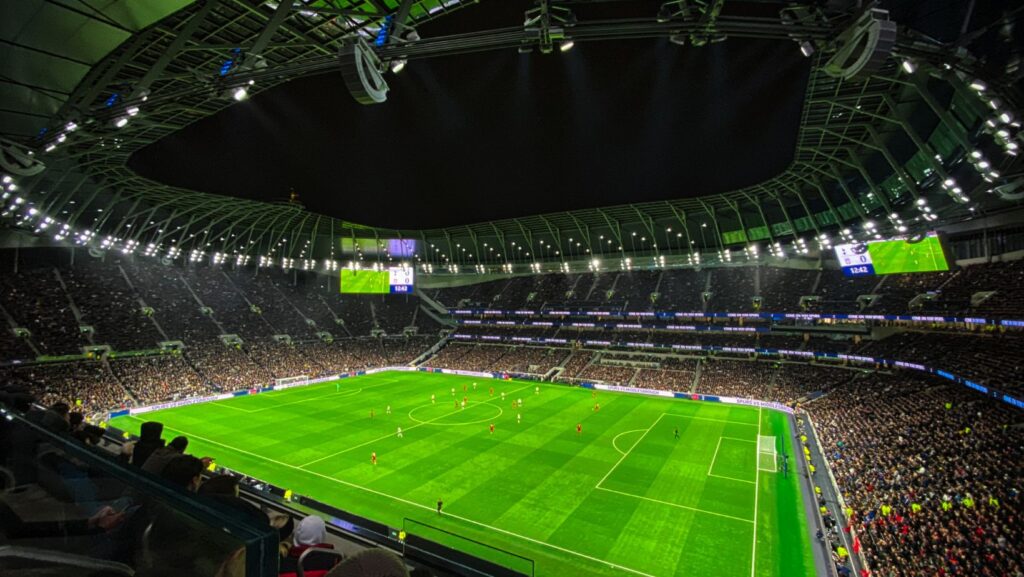
Walk into a stadium in 2030 and it won’t feel like the ones you grew up with. The grass still smells the same, the crowd still buzzes before kickoff, and that shared heartbeat before a goal is still there but everything around it hums differently. The walls think, the lights react, and the network listens. Football’s future isn’t just played on the pitch anymore. It’s coded into the air around it.
The Smart Stadium Becomes the Norm
By the end of this decade, almost every major arena will run on its own digital nervous system. Sensors under the seats, cameras above the stands, and edge computing nodes tucked behind the walls will keep everything alive, temperature, crowd flow, even the rhythm of chants.
You won’t be holding a ticket stub. You’ll be walking through a gate that recognizes you. Your phone, or maybe your glasses, will flash player data in real time. When a midfielder breaks a sprint line or a striker hits a new top speed, it appears right in your view.
The tech won’t shout for attention. It will just be there, blending into the matchday hum, making sure everything works a little smoother.
The Fan as Part of the System
Every fan in the stadium becomes part of the data loop. Every cheer, every tap on the screen, every order of food adds to what the system knows. By 2030, stadium AI will predict where congestion builds and open extra kiosks before you even see the queue. The same system might nudge you toward your favorite snack stand or flash a discount on your screen when your team scores.

It’s personalization taken to the pitch. Betting platforms will tie into this same ecosystem, letting fans place real-time soccer betway wagers from their seats as match data updates instantly. You’ll get your own view of the game, your favorite player’s heat map, real-time shot data, and even emotion-based highlights drawn from crowd reactions.
There’s a trade-off, of course. Every movement becomes measurable. Fans stop being anonymous energy and start becoming tracked behavior. The best stadiums will find balance using the tech to enhance the chaos, not tame it.
When the Pitch Becomes a Sensor
For players, the transformation will be even deeper. Every blade of grass, every stride, and every breath will feed into a performance system that never sleeps. Sensors stitched into jerseys and boots will sync directly with the stadium’s edge network.
That means coaches see heart rates, fatigue levels, and positional data instantly. No delay, no buffering. A manager might spot a tired fullback seconds before the mistake happens. Sports science becomes part of the live match, not an afterthought on Monday morning.
The risk? Over-analysis. Too much information, too little intuition. Some managers will rely on it. Others will rebel, trusting instinct over algorithms. The best will learn to merge both.
The Connected Crowd
Fans have always been the loudest part of the game, but in 2030 the stadium will finally listen. Microphones across sections will read the decibel levels of chants and balance them so the whole ground moves in rhythm.
Some venues are already testing reactive lighting, when the noise hits a certain pitch, LEDs ripple across the stands. It turns the roar into part of the spectacle, an actual feedback loop between crowd and architecture.
There’s something beautiful about that idea. Football has always been about collective emotion. Now, the building itself will feel it too.
Green Energy and Smarter Spaces
Technology isn’t just changing the experience; it’s reshaping how stadiums live. By 2030, major clubs aim to make their grounds energy self-sufficient. Solar-panel roofs, kinetic floors that turn footsteps into power, and AI systems that manage ventilation will keep the carbon footprint low without killing the atmosphere.
Fans will even see it happening live sustainability dashboards showing how much energy the crowd is generating just by being there. Imagine celebrating a goal and knowing that noise literally helped power the lights above you.
What the Game Gains — and What It Could Lose
There’s no question that football will be more efficient, safer, and better connected. But there’s also a quiet risk that it becomes too clean. The beauty of the sport has always been in its chaos: the mistimed tackle, the unexpected bounce, the roar that drowns out logic.
The technology of 2030 will make everything smoother. The challenge will be keeping it human. The best clubs won’t use tech to control fans or players. They’ll use it to bring them closer — to amplify emotion, not manage it. When the whistle blows in 2030, the grass will still be green, the fans will still sing, and the stadium will still shake. But now, the stadium will be listening too.












